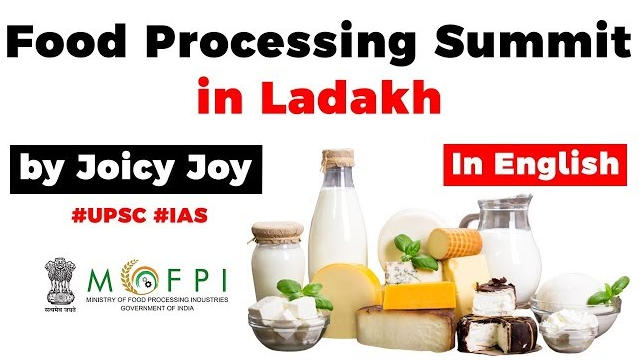Table of Contents
CURRENT AFFAIR
- On January 16, 2020, the Department of Industries and Commerce, functioning under Ministry of Food Processing Industries organized food processing summit in Ladakh.
- The other stakeholders of the summit include Invest India and National Investment Promotion and Facilitation agency.
AIM
- Ladakh Food Processing Summit aimed to carry out a value chain mapping of food processing in Ladakh.
- It recommends strategies for integrating the local population into food processing and agriculture activities, to maximize the potential of the sector.
HIGHLIGHTS
- The Summit was attended by food producers of Ladakh. It included producers of milk, barley, meat, organic vegetables, apples and apricots.
- The Ladakh Action Plan for Food Processing to promote food processing was presented at the summit.
- The summit focused on chain mapping of food processing and recommended strategies to integrate local population towards agriculture and food processing.
- It also focused primarily on Leh and Kargil regions.
Current Scenario
- Ladakh has the potential for growing cereals, vegetables and food grains.
- But agriculture has now taken back seat in the rapid growth of the region.
- Agriculture has lost its place to the growing tourism in the region.
- Also, the other reasons for decreased participation of agricultural activities include low cropping intensity, short agriculture season and less productivity.
Government measures
- GoI adopts improved green houses, poultry farming, lambing shed, value addition and marketing of horticultural products and compost pits.
- It introduces high yielding crop varieties, seed production techniques, organic farming.
- The Union Government is also motivating farmers to adopt cold weather technologies to increase production.
FOOD PROCESSING
- Food Processing includes process under which any raw product of agriculture, dairy, animal husbandry, meat, poultry or fishing is transformed through a process in such a way that its original physical properties undergo a change and the transformed product has commercial value and is suitable for human and animal consumption.
- It also includes the process of value addition to produce products through methods such as preservation, addition of food additives, drying etc. with a view to preserve food substances in an effective manner, enhance their shelf life and quality.
Significance
- Employment Generation.
- Doubling of farmers’ income
- Reduce malnutrition
- Reduce food wastage.
- Boosts Trade and Earns Foreign Exchange
- Curbing Migration
- Curbing Food Inflation
- Crop-diversification.
- Preserve the nutritive quality of food and prolongs the shelf life
- Enhances the quality and taste of food
- Enhances consumer choices
Status of Food Processing In India
- India is the world’s second largest producer of fruits & vegetables after China but hardly 2% of the produce is processed.
- In spite of a large production base, the level of processing is low (less than 10%). Approximately 2% of fruits and vegetables, 8% marine, 35% milk, 6% poultry are processed.
- Most processing in India can be classified as primary processing, which has lower value-addition compared to secondary processing.
- At present, India’s agricultural exports predominantly consist of raw materials, which are then processed in other countries
Ministry of Food Processing Industries
- It is responsible for formulation and administration of the rules and regulations and laws relating to food processing in India.
- Ministry has also been instrumental in helping farmers and have approved 42 mega food parks.
- It provides financial support of 35% of the total cost of plant and machinery for encouraging growth in food processing.
Pradhann Mantri Kisan Sampada Yojna
- (PMKSY) is a central sponsored scheme under Ministry of Food Processing Industries.
- It is a scheme for Agro-Marine Processing and Development of Agro-Processing Clusters.
- It is a big step towards doubling of farmer’s income through the assets (Sampada) of farmer.
- It is a comprehensive package which will result in creation of modern infrastructure with efficient supply chain management from farm gate to retail outlet.
- It will provide a big boost to the growth of food processing sector in the country and creates huge employment opportunities in the rural areas, reducing wastage of agricultural produce and increasing the food processing level and its export.
Indian Institute of Food Processing Technology (IIFPT)
- It is a pioneer Research and Educational Institution under the Ministry of Food Processing Industries.
- The Institute was later upgraded as a national laboratory with the name Paddy Processing Research Centre (PPRC) in 1972.
- At the time of up-gradation the mandates of the Institute were also changed and the scientists in the Institute focused their research in identifying technologies for post-harvest procession and preservation of paddy.
- The Institute was moved to its current location at Thanjavur in 1984.
- The IIFPT with its modern laboratories equipped with hi-tech instruments, is engaged in the R&D of food grain processing, value addition, by-product utilization through bio-processing, process and product development.
Latest Burning Issues | Free PDF






















 WhatsApp
WhatsApp